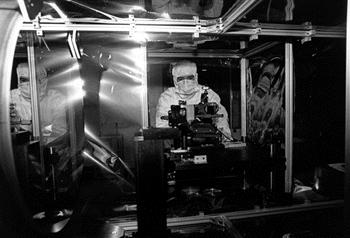|
|
Group Designs and Fine-Tunes the Instruments of ScienceBy Michael PurdyHomewood |

As Gregg Scharfstein's classmates were feverishly sending out their resumes this past spring, prepping for interviews and fretting over crucial decisions on job offers, Sharfstein had considerably less on his mind.
Finals, definitely. The start of Yankees baseball, maybe. But a job? Nope, he already had that in the bag. For Scharfstein, graduation was simply the climax of an extremely enviable feat: Not only had he found the job of his dreams before graduation, he kept it after he graduated. He had been, and would continue to be, a mechanical engineer for the Johns Hopkins Instrument Development Group.
 |
| Robert Barkhouser, an optical engineer with the Instrument Development Group, uses the laser interferometer in a special "clean room," where instruments are assembled and tested. |
Scharfstein met his future full-time employers through a tip from a friend on an "April-to-summer" job when he was in his junior year and majoring in mechanical engineering.
"I thought it would just be a simple clerical job answering phones and things like that," he remembers.
Scharfstein's future employers had more in mind. They were a group of engineers who needed engineering support for an instrument design project.
For years, Hopkins had hired such engineers on a contract basis. They were brought in to work on specific projects, and when the projects ended, they either found a new one or were let go. Concerned about the loss of talent and the impediments to recruitment this caused, the engineers who hired Scharfstein were a few months away from forming a permanent group, the Instrument Development Group, to make sure Hopkins could recruit and retain talented engineers.
Formally established in July 1999, IDG literally does everything in the instrument development process, and that's what made Scharfstein so fond of working there, both as a part-time job and as a full-time career.
"As an engineer, if you go to work for a big firm, a lot of what you do gets contracted out," Scharfstein explains. "Here at IDG, it's yours; you do everything. The four of us involved in the project I've been working on went down to the National Institute of Standards and Technology and gave a two-hour presentation, and when we were done, the people at NIST said, 'Hey, where's the rest of your engineering team?' and we said, 'This is it.' "
Projects to which IDG has provided support have included the Far-Ultraviolet Spectroscopic Explorer, the Sloan Digital Sky Survey, CONTOUR (Comet Nucleus Tour, an APL/Cornell/NASA project), the Hopkins sounding rockets program and the Hopkins Ultraviolet Telescope. The staff includes two optical engineers, Robert Barkhouser and Steve Conard; two electrical engineers, Joe Orndorff and Tom Reeves; Scharfstein, a mechanical engineer; and a student intern majoring in physics.
The team Scharfstein works on is designing and building a device known as a neutron monochromator. When completed next spring, the monochromator will go into a neutron particle beam used by NIST to analyze materials.
"The monochromator will allow them to aim the neutron beam at a target," Scharfstein explains. "You have to have some type of reflecting material to orient the beam the way you want. The older machines have motors and all kinds of junk behind the reflective surfaces, and all that stuff reflects neutrons inadvertently, and it kind of messes up your data."
The IDG's new design should reduce that problem greatly by putting the motors and control systems above and below the reflectors.
Scharfstein says the job continues to be an excellent learning experience, even after graduation.
"The people I work with at IDG have a very good attitude, and they really show you how to do things right," he says. "You just take a few extra steps, and put in a little extra effort, and you can get it done right and know it's going to work and have confidence in it."
It gets to the point where he has to be careful about discussing his day at work, Scharfstein says.
"A lot of my friends really hate to hear about how much I love my job," he says, smiling. "Coming to work is not a big deal for me, and they don't want to hear about that."
Although the IDG's charter states that its main purpose is to support research in the Physics and Astronomy Department, the group is looking for opportunities to support other departments at JHU. IDG engineers have also helped support JHU student research.
For more information, visit IDG's Web page http://www.pha.jhu.edu/facilities/idg or call 410-516-8390.
| GO TO NOVEMBER 27, 2000 TABLE OF CONTENTS. |
| GO TO THE GAZETTE HOME PAGE. |